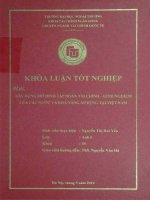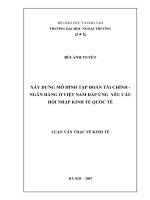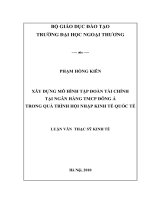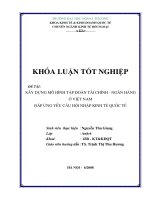Xây dựng mô hình đánh giá tài chính SOM
Bạn đang xem bản rút gọn của tài liệu. Xem và tải ngay bản đầy đủ của tài liệu tại đây (188.15 KB, 2 trang )
1
S D ng SOM (Self-Organizing Map) Xây D ng Mô Hình
ánh Giá Tài Chính Doanh Nghi p
H
ng d n: PGS.TS Lê Hoài B c; Th c hi n: Nguy n Kh c Thìn
Tóm t t—M c tiêu c a nghiên c u này là s xây d ng m t
mô hình đánh giá tài chính doanh nghi p trong ngành cung c p
d ch v vi n thông s d ng b n đ t t ch c. Mô hình s bao
g m các quá trình: l a ch n công ty, thu th p d li u, phát hi n
và lo i b bi t l , chu n hoá d li u, hu n luy n và cho k t qu
đánh giá tài chính. Gi i thi u các tu bi n khi tri n khai mô
hình, cài đ t ng d ng h tr các tác v c a mô hình.
T khoá—Khai phá d li u, b n đ t t ch c, bi t l , chu n
hoá d li u, gom c m, đánh giá tài chính.
I. K T QU
Nghiên c u đã xem xét m t s cách ti p c n kh d đ phân
tích d li u tài chính c ng nh xem xét c s c a vi c s d ng
SOM trong đánh giá tài chính doanh nghi p.
Nghiên c u đã đ xu t mô hình đánh giá tài chính các
doanh nghi p v i nhi u tu bi n.
Nghiên c u đã l a ch n và thu th p d li u tài chính liên
quan cho nghiên c u c a 101 công ty hàng đ u toàn c u trong
giai đo n 2000-2004 trong l nh v c cung c p d ch v vi n
thông.
D li u thu th p đ c x lý bi t l , chu n hoá tr c khi
đ a vào hu n luy n. Ch t l ng hu n luy n đ c đánh giá
theo l i l ng t hoá và l i topo b n đ .
B n đ thu đ c qua hu n luy n đ c gom c m. Tr c quan
hoá b n đ ta thu đ c các đánh giá s b các c m, xu h ng
ho t đ ng c a các doanh nghi p.
Nghiên c u đã cài đ t ng d ng h tr quá trình hu n luy n
d li u, đánh giá ch t l ng hu n luy n, gom c m, gán nhãn
và mã hoá màu b n đ SOM thu đ c qua hu n luy n.... Các
k t qu vào ra c a ng d ng đ u có th đ c s d ng tr c ti p
t các gói ph n m m hu n luy n và tr c quan SOM khác nh
SOMPAK và SOM Toolbox for Matlab (c hai ng d ng này
đ u do đ i h c Helsinki, Ph n Lan phát tri n).
Tri n khai các mô hình đánh giá tài chính khác c ng nh áp
d ng các tu bi n khác vào mô hình này đ có các k t qu đ i
ch ng
TÀI LI U THAM KH O
[1]
[2]
[3]
[4]
[5]
[6]
[7]
[8]
[9]
[10]
[11]
[12]
[13]
[14]
[15]
[16]
II. H
NG PHÁT TRI N
i chi u k t qu đánh giá t mô hình v i đánh giá trong
báo cáo tài chính hàng n m đ đánh giá đ chính xác c a mô
hình. Ngoài ra, mô hình c n nh n đ c s đánh giá c a các
chuyên gia tài chính đ c i thi n đ tin c y
Xây d ng mô hình đánh giá cho th c ti n Vi t Nam
Nguy n Minh Ki u (2005), Phân tích tài chính, Ch ng trình Gi ng
d y Kinh t Fulbright, Niên khoá 2005-2006.
Charnes, A., W. W. Cooper and E. L. Rhodes (1978), “Measuring the
efficiency of decision making units,” European Journal of Operational
Research 2(6): 429- 444.
Eklund, T., B. Back, H. Vanharanta and A. Visa (2002), “Assessing the
Feasibility of Self-Organizing Maps for Data Mining Financial
Information,” The Xth European Conference on Information Systems,
Gdansk, Poland, June 6-8: 528-537.
Eklund, T., B. Back, H. Vanharanta and A. Visa (2004), “Financial
Benchmarking Tools in Finnish Companies – A State of the Art
Survey,” Turku Centre for Computer Science, Finland.
Eklund, T. (2004), “The Self-Organizing Map in Financial
Benchmarking,” Doctoral Dissertation, Turku Centre for Computer
Science, Finland.
Eklund, T. (2005), “Financial Ratio Analysis, Financial Benchmarking,
and Self-Organizing Maps - A Current Research Example,” Åbo
Akademi University, Finland.
Fayyad, U., G. Piatetsky-Shapiro and P. Smyth (1996), “The KDD
Process for Extracting Useful Knowledge from Volumes of Data,”
Communications of the ACM 39(11): 27-34.
Kaplan, R. S. and D. P. Norton (1992), “The Balanced Scorecard Measures that Drive Performance,” Harvard Business Review 70(1):
71-80.
Karlsson, J. (2001), “Benchmarking Telecommunication Companies
Using Self-Organising Maps,” Master Thesis in Information Systems,
Åbo Akademi University, Finland.
Kohonen, T. (2001), Self-Organizing Maps, Springer-Verlag, Berlin.
Marghescu, D. and M.J. Rajanen (2005), “Assessing the use of the SOM
technique in data mining,” Proc. of the 23rd IASTED Intl. MultiConf., Databases and Applications, Innsbruck, Austria.
Oja, E., S. Kaski and T. Kohonen (2002), “Bibliography of SelfOrganizing Map (SOM) Papers: 1998-2001 Addendum,” Neural
Computing Surveys 3, Helsinki University of Technology, Finland.
Pei, J. (2003), Data Mining, CSE 626, State University of New York at
Buffalo.
Spotfire Inc. (2003), Spotfire DecisionSite Statistics 7.2.
Vesanto, J., J. Himberg, E. Alhoniemi, J. Parhankangas (2000), “SOM
toolbox for Matlab 5,” Technical report A57, Helsinki University of
Technology, Finland.
Vesanto, J. and E. Alhoniemi (2000), “Clustering of the Self-Organizing
Map,” IEEE Transactions on Neural Networks 11(3): 586-600.
2
Financial Benchmarking International Telecom Services
Companies Using Self-Organizing Maps
Supervisor: Le Hoai Bac; Executor: Nguyen Khac Thin
Abstract— This research aims to build a model for financial
benchmarking in the international telecommunication services
companies using self-organizing maps. The model includes the
following processes: choosing the companies, collecting the data,
data preprocessing, training the network, visualizing, producing
financial benchmarking results. Some options for developing the
model will be presented. An application that supports training
and visualizing the map will be implemented.
Index Terms—Data mining, self-organizing map, outlier, data
normalization, clustering, visualizing, financial benchmarking.
I. RESULTS
We reviewed some approaches to analyze financial data as
so as considered backgrounds for using SOM in
benchmarking companies.
We proposed a model for financial benchmarking
companies with many options.
We collected seven financial ratios for 101 telecom services
companies in the period 2000-2004.
The data were detected and removed outliers. Then they
were normalized. After these processes, the data were trained
with SOM. The quality of the training process was estimated
in both measures: average quantization error and topographic
error.
The map we got after a good training was cluster using the
hierarchical approach. By visualizing the map in some views,
we can estimate the financial performance of the companies in
the clusters.
We also implemented an application that supports training,
estimating the quality of the training process, clustering,
coloring, labeling and visualizing the map. Inputs and outputs
for the application can be used by other SOM packages.
II. FUTURE RESEARCH
Results from the model should be compared with the annual
reports of the companies. In addition, the model should be
estimated by financial experts.
Developing the model for Vietnamese companies.
Comparing the model with other models as so as adding
new options for the processes of the model
Manuscript received October 1, 2006.
Lê Hoài B c is with Faculty of Information Technology, Hochiminh
University of Natural Sciences, Hochiminh City, Vietnam (e-mail: baclh@
fit.hcmuns.edu.vn).
Nguy n Kh c Thìn, is studying at University of Information Technology,
Hochiminh
City,
Vietnam
(phone:
84903-689-054;
e-mail:
).








